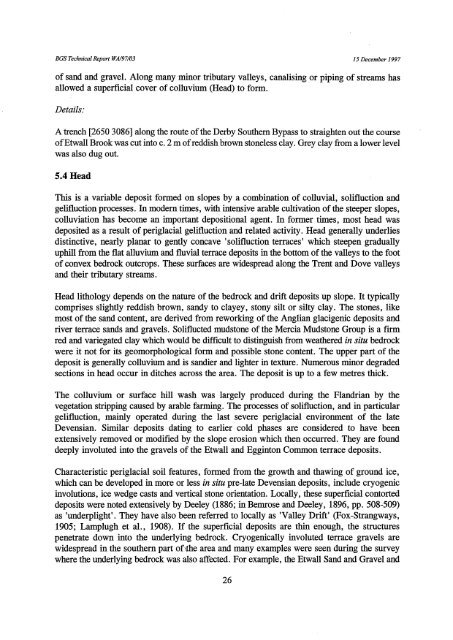Download (3723Kb) - NERC Open Research Archive - Natural ...
Download (3723Kb) - NERC Open Research Archive - Natural ...
Download (3723Kb) - NERC Open Research Archive - Natural ...
Create successful ePaper yourself
Turn your PDF publications into a flip-book with our unique Google optimized e-Paper software.
BGS Technical Report WA/97/03 15 December 1997<br />
of sand and gravel. Along many minor tributary valleys, canalising or piping of streams has<br />
allowed a superficial cover of colluvium (Head) to form.<br />
Details:<br />
A trench [2650 30861 along the route of the Derby Southern Bypass to straighten out the course<br />
of Etwall Brook was cut into c. 2 m of reddish brown stoneless clay. Grey clay fiom a lower level<br />
was also dug out.<br />
5.4 Head<br />
This is a variable deposit formed on slopes by a combination of colluvial, solifluction and<br />
gelifluction processes. In modern times, with intensive arable cultivation of the steeper slopes,<br />
colluviation has become an important depositional agent. In former times, most head was<br />
deposited as a result of periglacial gelifluction and related activity. Head generally underlies<br />
distinctive, nearly planar to gently concave ' solifluction terraces' which steepen gradually<br />
uphill from the flat alluvium and fluvial terrace deposits in the bottom of the valleys to the foot<br />
of convex bedrock outcrops. These surfaces are widespread along the Trent and Dove valleys<br />
and their tributary streams.<br />
Head lithology depends on the nature of the bedrock and drift deposits up slope. It typically<br />
comprises slightly reddish brown, sandy to clayey, stony silt or silty clay. The stones, like<br />
most of the sand content, are derived from reworking of the Anglian glacigenic deposits and<br />
river terrace sands and gravels. Soliflucted mudstone of the Mercia Mudstone Group is a firm<br />
red and variegated clay which would be difficult to distinguish from weathered in situ bedrock<br />
were it not for its geomorphological form and possible stone content. The upper part of the<br />
deposit is generally colluvium and is sandier and lighter in texture. Numerous minor degraded<br />
sections in head occur in ditches across the area. The deposit is up to a few metres thick.<br />
The colluvium or surface hill wash was largely produced during the Flandrian by the<br />
vegetation stripping caused by arable farming. The processes of solifluction, and in particular<br />
gelifluction, mainly operated during the last severe periglacial environment of the late<br />
Devensian. Similar deposits dating to earlier cold phases are considered to have been<br />
extensively removed or modified by the slope erosion which then occurred. They are found<br />
deeply involuted into the gravels of the Etwall and Egginton Common terrace deposits.<br />
Characteristic periglacial soil features, formed from the growth and thawing of ground ice,<br />
which can be developed in more or less in situ pre-late Devensian deposits, include cryogenic<br />
involutions, ice wedge casts and vertical stone orientation. Locally, these superficial contorted<br />
deposits were noted extensively by Deeley (1886; in Bemrose and Deeley, 1896, pp. 508-509)<br />
as 'underplight'. They have also been referred to locally as 'Valley Drift' (Fox-Strangways,<br />
1905; Lamplugh et al., 1908). If the superficial deposits are thin enough, the structures<br />
penetrate down into the underlying bedrock. Cryogenically involuted terrace gravels are<br />
widespread in the southern part of$he area and many examples were seen during the survey<br />
where the underlying bedrock was also affected. For example, the Etwall Sand and Gravel and<br />
26
















